Sturm Graz have already scored 15 set play goals in the Austrian Bundesliga this season so far, making up 42% of their total goal tally thus far, which has left them within two points of league leaders RB Salzburg. They are also currently in the knockout stage of the UEFA Europa Conference League, although a 3-0 loss to Ligue 1 side Lille is likely too high a deficit to overturn.
After a deeper dive into the Austrian side’s set plays, it appears that although they have a very strong record from set pieces, it is reliant on who the taker is.
From only 25 corners taken this season by Tomi Horvat, Sturm Graz have been able to score four goals, win a penalty, and create six other high-quality headed chances inside the six-yard box. 44% of Horvat’s corner kicks have led to high-quality chances or goals.
In comparison, the remaining 150~ corners have been taken by various other players. Three of these corners have resulted in goals, while three were also scored in the resulting second phase. Furthermore, a very limited number of other chances were generated inside the six-yard box, which has been Sturm Graz’s aim. Only 2% of corner kicks taken by others led to high-quality chances.
This shows that while Sturm Graz are a strong set-play side, they are 22x more threatening from corner kicks when Horvat is lining up due to his excellent technique when striking the ball.
In this tactical analysis, we will look into the tactics behind Sturm Graz’s corner kicks, with an in-depth analysis of how they are able to access the near side of the six-yard box. This set-piece analysis will also look into the different ways they have used to create additional space in the six-yard box and what could be done differently to ensure they remain a threat even when Horvat is not lining up to take the set play.
Attacking The Near Post
The intent from Sturm Graz is to make the first contact at the near side of the six-yard box. While it might not be easy to consistently deliver the ball into this area, the benefits teams can reap are enormous, and it is worth the risk for Sturm Graz. With Horvat, it is possible to ensure the ball can access this area, which is highlighted in the picture below. The ball usually has to clear the nearest defender before dipping down at the near side of the six-yard box. Through excellent timing, only one player needs to make the move into the highlighted area, with the confidence in Horvat that the ball will go exactly where planned.
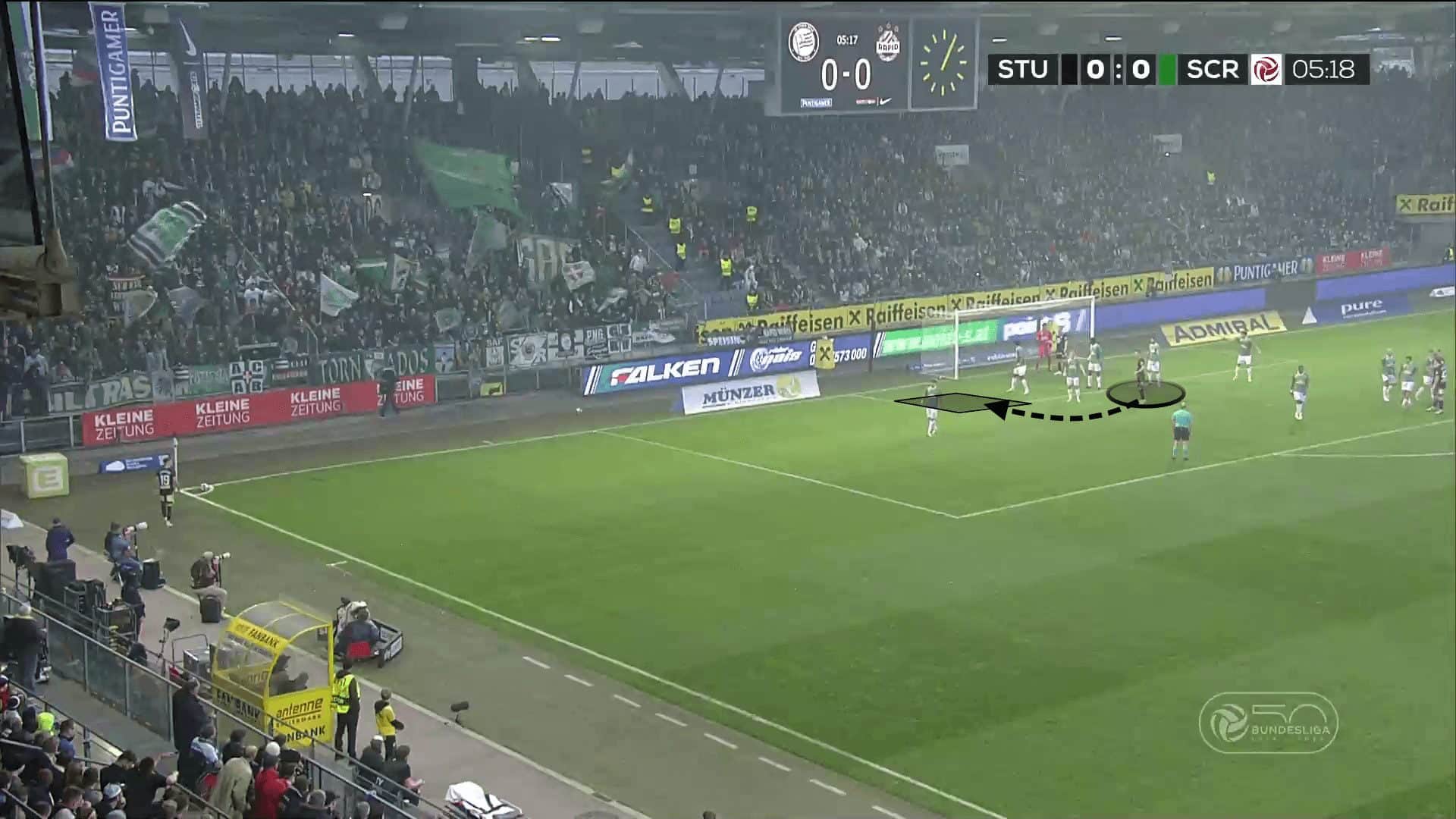
The starting position is extremely important to the success of the arrival into the target zone. As we can see, the area that Sturm Graz are targeting is exceptionally tight, but with their use of starting positions in the blindside, attackers can arrive in the limited space unmarked. The attackers move into the target area from the back half of the six-yard box. Defenders must remain goalside to prevent an easy header on goal, but in doing so, the path to run into the near side of the six-yard box opens up for the Sturm Graz attackers.
The timing of the run is vital and something that the Austrian side clearly has worked on. With the space being so minimal, the zonal defenders who spot an attacking run across them will instantly be able to step up and challenge for the ball. This means that the incoming attackers only have a split second, where they can be in the target area and unopposed. Sturm Graz have done excellent work in ensuring they arrive in the space at the same time as the ball does, to ensure the attacker can attack the ball without any opposition competition.
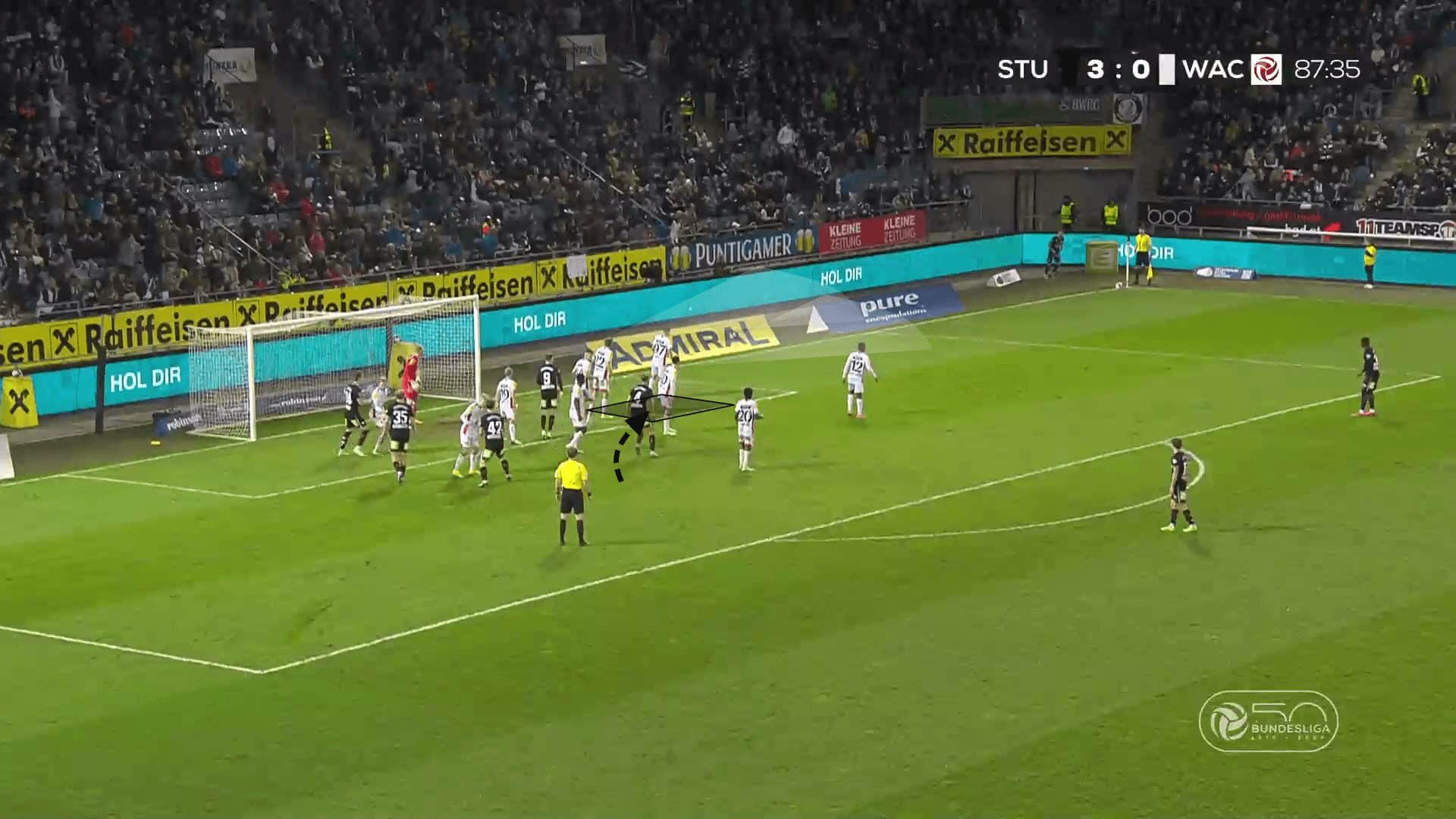
One way in which Strum Graz have been able to increase the margin of error for their corner taker has been through the use of a decoy run intended to drag zonal defenders away from the target area. As we can see below, the near zonal defender is located by the front post, but the attacker deliberately makes a move across the front of the defender to grab his attention and ensure he gets followed.
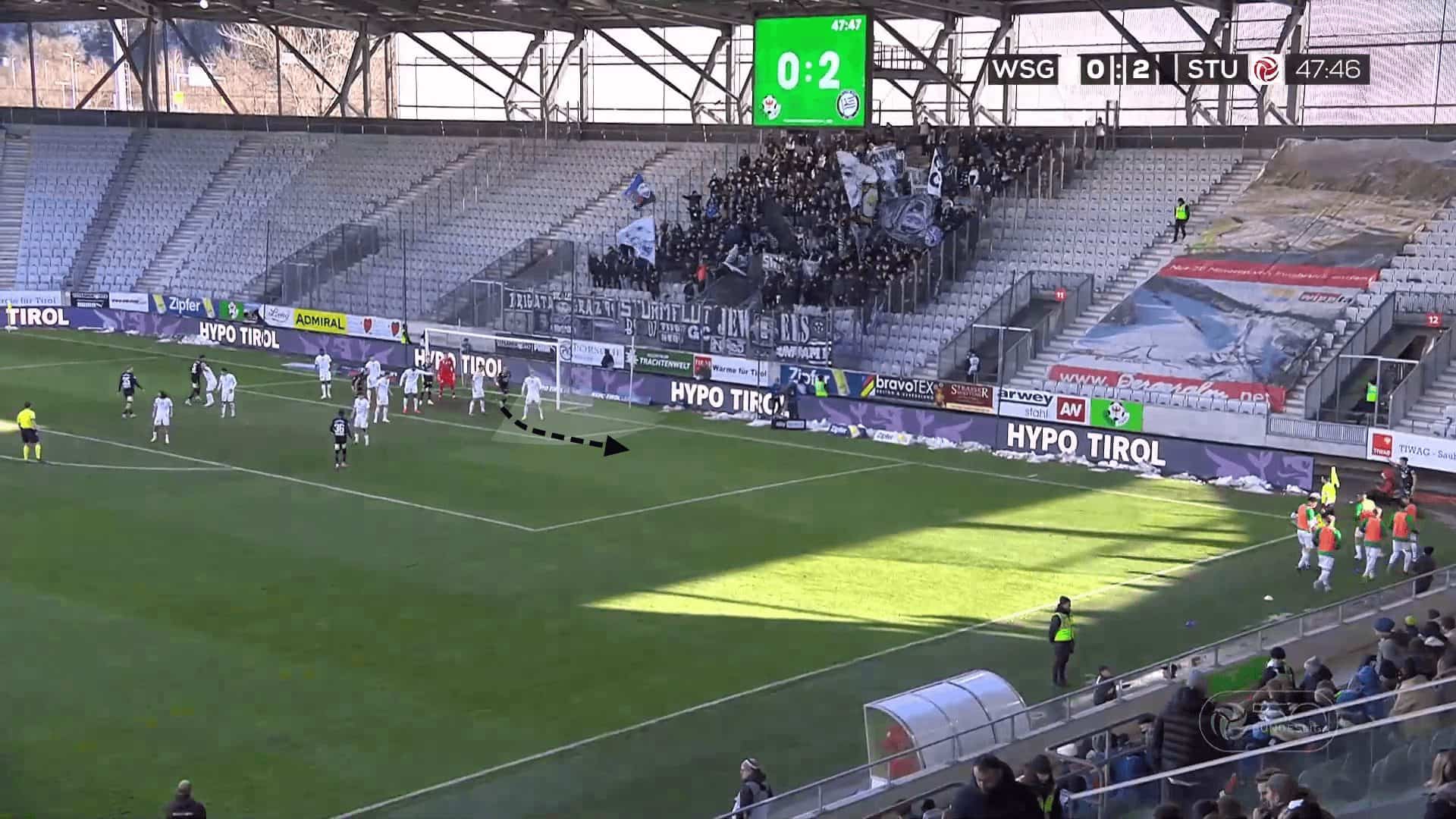
While the zonal defender vacates his zone, a player from the back side of the six-yard box is able to make his movement, arriving in the space from the blindside to ensure he arrives unopposed inside the six-yard box. With the decoy run moving towards the ball, he then receives a secondary role. He can remain useful in the attack by redirecting any underhit crosses through flicks, which prevents the opposition from clearing the ball and increasing the chance of Sturm Graz sustaining pressure following the corner kick, no matter how poor the delivery is.
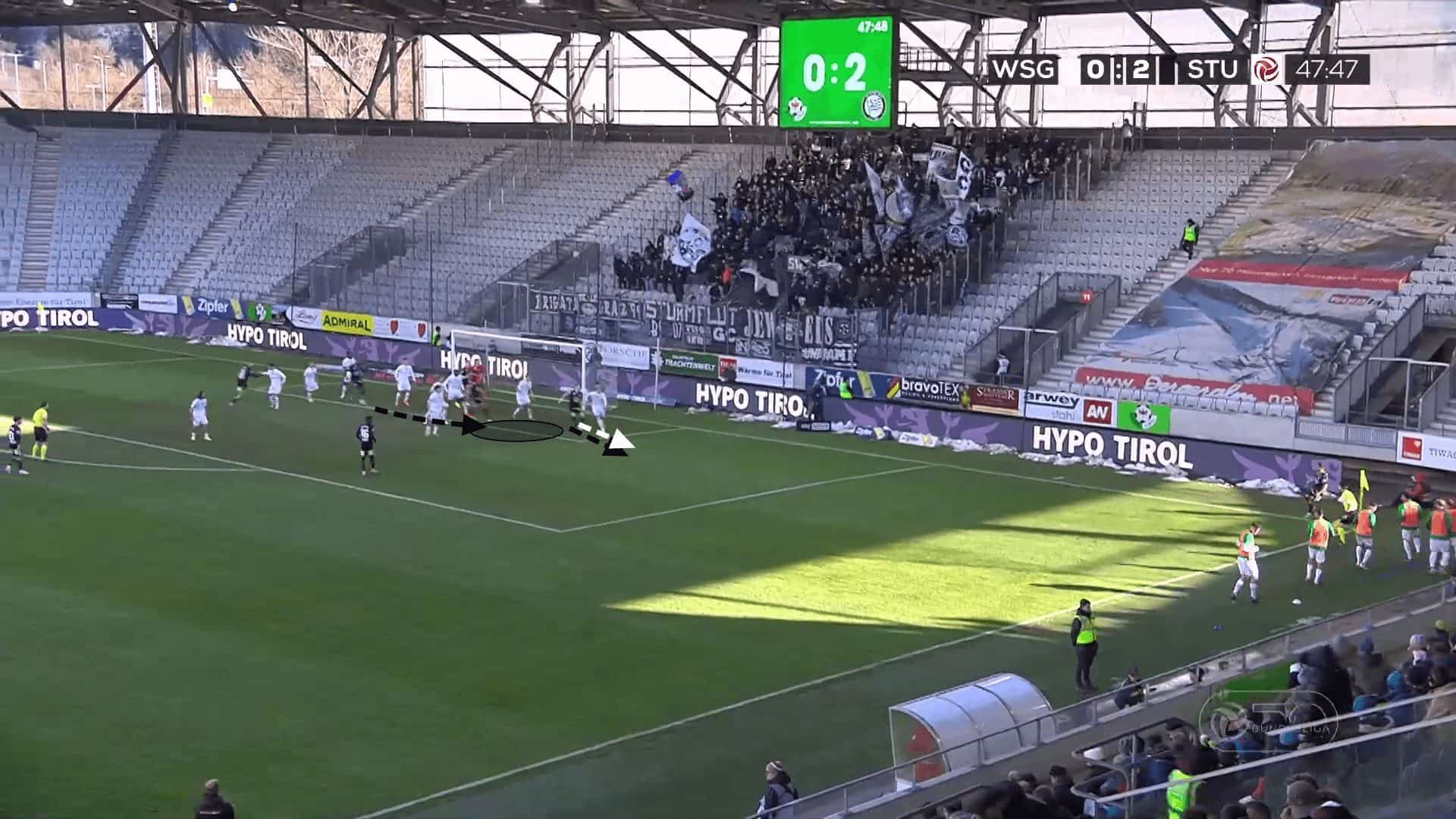
Another idea used to increase the space available to deliver into is through the introduction of screens. The previous examples showed Sturm Graz attempting to lure defenders away from the six-yard box. This time, the plan is to trap defenders inside the six-yard box, preferably within the width of the goalposts. Similarly to the decoy run, this gives the attacker, arriving from the blindside, the opportunity to have more space to attack, with the possibility to recover an underhit cross.
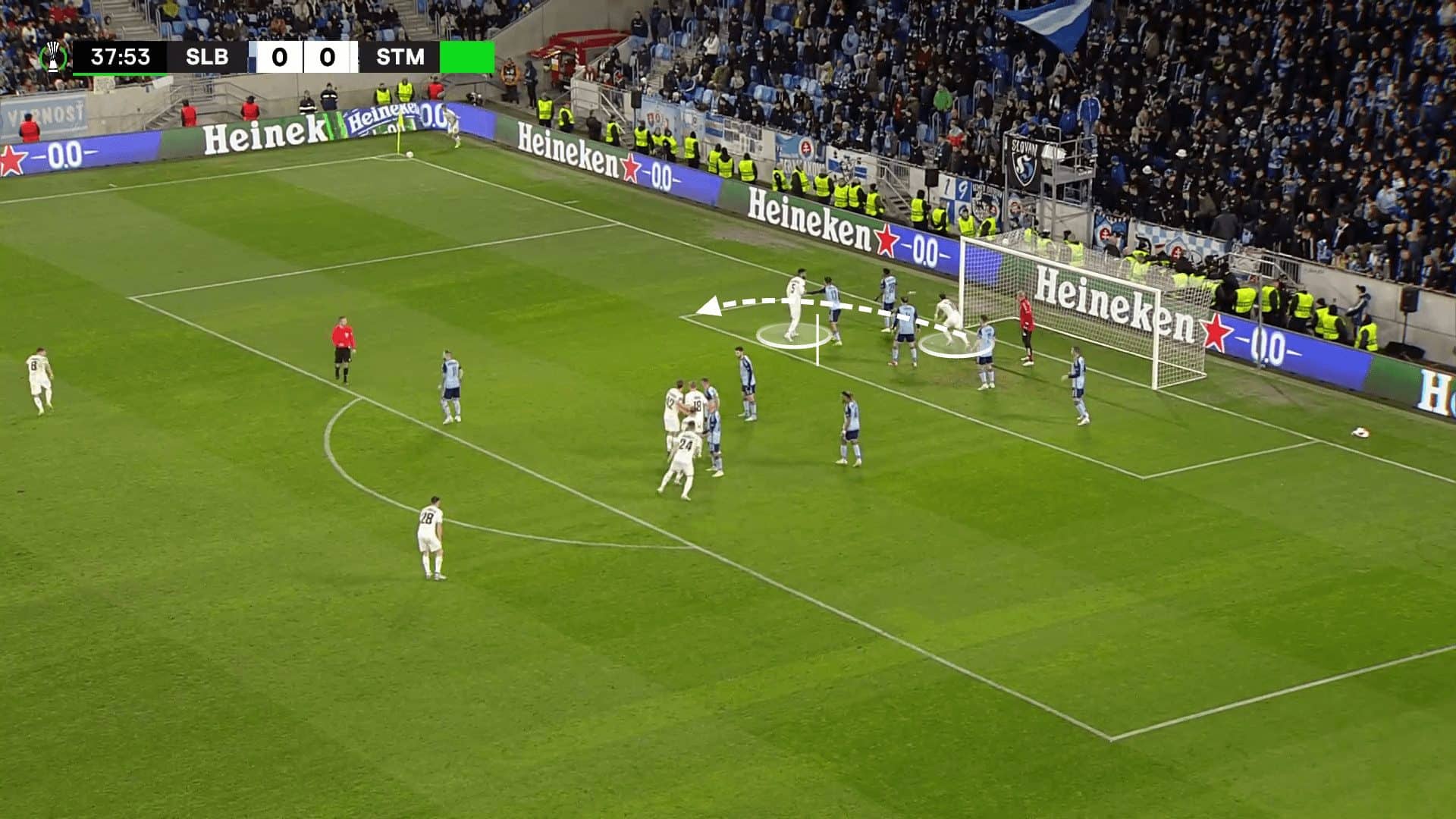
Although the intention is positive, there appears to be a lack of cohesion and clarity within the team. With the attacker arriving from behind the defender, he has the initial yard of separation, which allows him to move freely inside the box. As a result, the screen being set should focus on preventing the nearest defender from accessing the target area rather than stopping him from chasing the marker.
We mentioned earlier in the article that Sturm Graz has worked well on timing its runs to arrive in space, as the ball does. This means that defenders chasing their marker should be a positive sign, as it means they aren’t marking tightly, and by the time they catch their marker, the ball will have already been headed goalwards.
In the scenario below, the screen should be orientated perpendicular to the goal to prevent the defender from being able to intercept the delivery by waiting in the target area. With the screen protecting the attacker from deep, the defender has a clear path to cut a corner and cut off the attacker’s run.
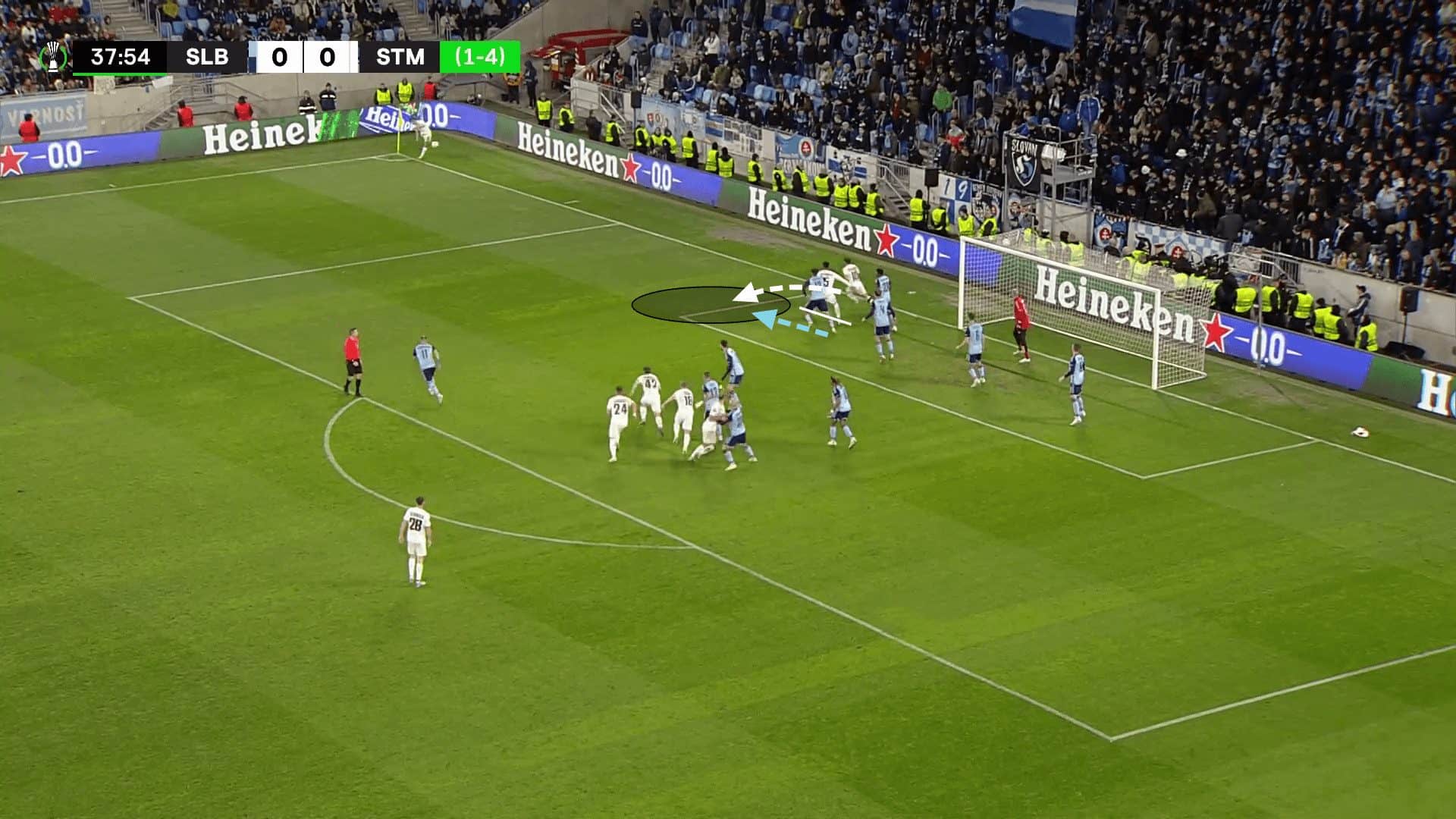
Apparent Problems without a Precise Delivery
When Horvat is not taking the corner kicks, the tactical problems and lack of proactive efforts to create solutions become evident. There are a series of movements that could be changed to give the other corner takers a higher margin of error with their crosses, which is a must based on the earlier statistics mentioned.
As seen throughout the season so far, Sturm Graz want to attack the near side of the six-yard box.
When anyone else steps up to the corner, the space to cross the ball into is too small for players to be able to repeat the cross consistently. The majority of other corner kicks result in being overhit or underhit. With Sturm Graz banking on the delivery being precise, they do little else in other areas of the penalty area. Overhit crosses float towards the back post and can be claimed by the goalkeeper, with no effort being made to prevent the goalkeeper from being able to do so. At other times, the cross moves towards the penalty spot, where attackers have no advantages in the aerial duels, meaning they must try to score a header from 12 yards while trying to compete for the aerial duel and also generate power in their shots. This is actually how that 2% value of their goals scored came about, with no other player being able to flawlessly deliver the ball into the space at the near side of the six-yard box.
With goalkeepers having the space to roam and usually a lack of attacking presence around the back post, there is no reason for defending teams to protect the back side of the six-yard box as heavily. Once the opposition realise this, they can increase the number of man-markers and change their roles to block the path of any player from reaching the near side of the six-yard box, rather than necessarily remaining goalside. This more so applies to players inside the six-yard box, where there is no potential to create a momentum advantage to aid aerial duels over zonal defenders.
Sturm Graz use a very scattered approach to their starting positions of players, meaning that each player is isolated from their teammates on most occasions. As a result, every defender can get as touch-tight to the attackers as they like. Currently, the solution for attackers has been to move toward the ball rather than the goal from the blindside, but as defenders start to realise the threat of a Sturm Graz player moving towards the goal is virtually non-existent, they can begin to change their positions and nullify Sturm Graz’s only threat, blocking access to the near edge of the six-yard box.
For the time being, Sturm Graz hasn’t had to deal with this yet and, as a result, has been able to maintain its success. However, once teams start to block players from making their moves into that near-side zone, Sturm Graz will become toothless from corner kicks unless they adapt again.
Sturm Graz could alter the starting positions so the attackers start close to each other or start as a pack, which will give each attacker more protection and prevent the opposition from being able to get touch-tight instantly. This will enable Sturm Graz to maintain their threat of accessing the near side of the six-yard box whilst also possessing the potential to attack other areas of the six-yard box so that when someone else is taking the corner, they have a more significant margin for error.
Currently, when Sturm Graz attempt to attack any area other than the near side of the six-yard box, we can see clear issues stemming from a lack of preparation. The example below shows three attackers scattered around the width of the goal, with a fourth attacker arriving from deep. The intent is similar for the attackers, trying to come from the blindside to arrive in space, but with the movements intended to target the space at the center of the six-yard box, the increased presence of zonal defenders combined with the goalkeeper’s anticipation means that there is almost no room to exploit.
At the centre of the six-yard box, more defenders are waiting for the ball, as well as the man-markers who can remain tight to attackers as they are positioned in the direction of the attacker’s intended to run.
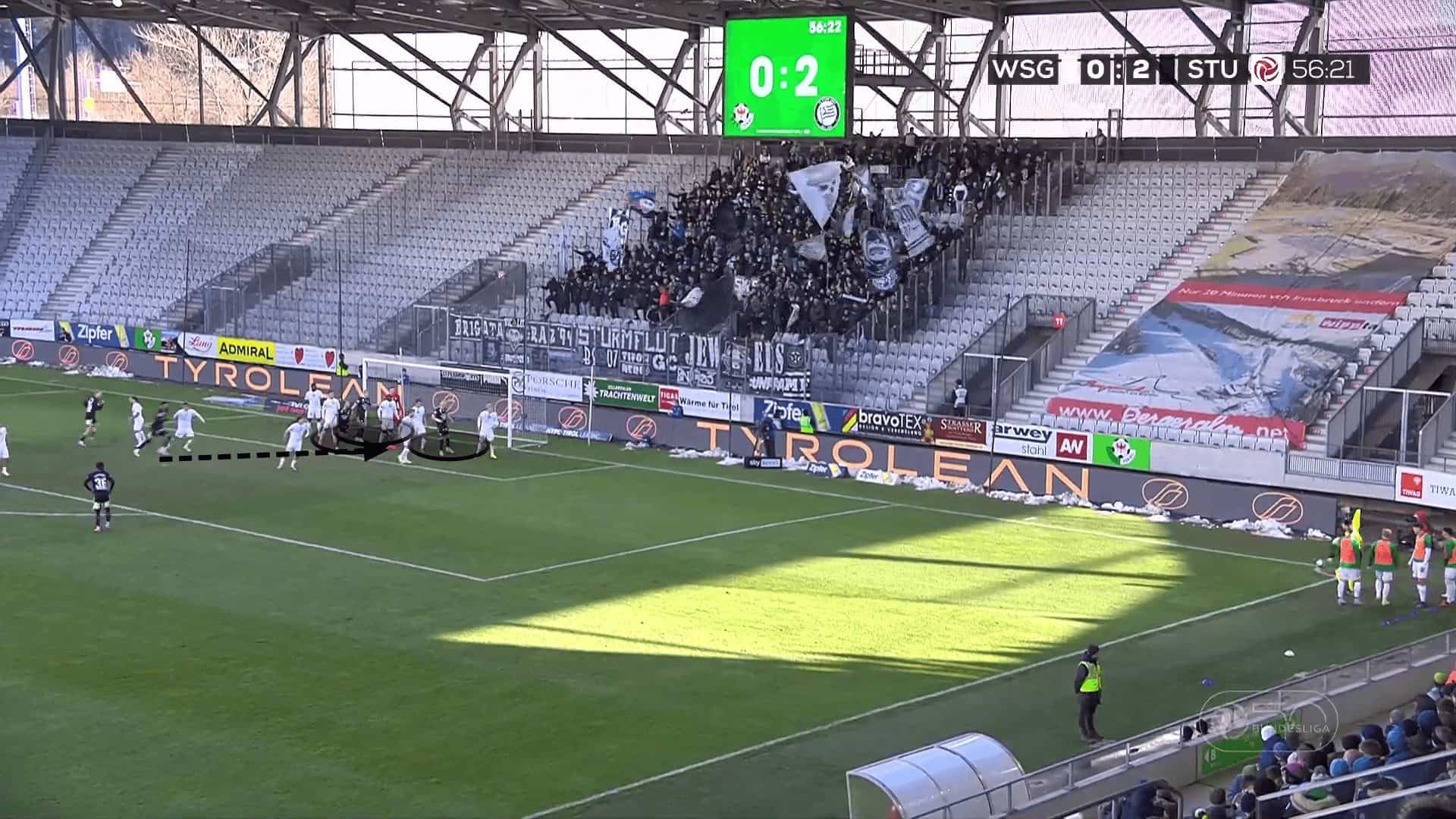
Summary
This tactical analysis has detailed how Sturm Graz have consistently created chances by the near post. A good set-piece taker can make or break a routine for the Austrian side, with the precision required being at a level unattainable by other players, giving Sturm Graz many different levels of efficiency from corners dependent on the corner taker, with the other moving parts remaining pretty consistent throughout the season during set-pieces.
At both the near and far sides of the six-yard box, defences are always a little less protected than the centre, but Sturm Graz have shown a lack of empathy for the situation, meaning they aren’t considering the change in the defensive presence and how much space is available in different parts of the six-yard box. The routine used by Sturm Graz has proven to be extremely effective, but a good set-piece team should be able to adapt to different pictures, identify the space potentially available, and figure out ways to access that space rather than using the same key to open different locks.






Comments